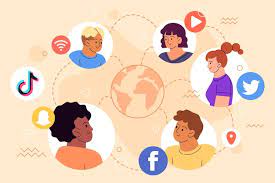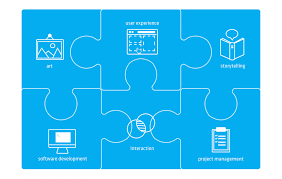Digital Media: Transforming the Way We Connect and Engage
In today’s fast-paced world, digital media has become an integral part of our lives. From social networking platforms to streaming services, it has revolutionized the way we connect, communicate, and consume information. With its ever-growing influence, digital media has transformed various aspects of our society, including business, entertainment, education, and even activism.
One of the most significant advantages of digital media is its ability to connect people across geographical boundaries. Social media platforms such as Facebook, Twitter, and Instagram have become virtual meeting places where individuals can share their thoughts, experiences, and interact with others from around the globe. This unprecedented level of connectivity has opened up new opportunities for collaboration and cultural exchange.
Digital media has also redefined the way businesses operate. It provides a cost-effective platform for companies to reach their target audience through targeted advertising campaigns and engaging content. With the rise of e-commerce platforms, businesses can now sell their products or services directly to consumers without the need for physical stores. This shift has empowered small businesses and entrepreneurs to compete on a global scale.
The entertainment industry has undergone a massive transformation with the advent of digital media. Streaming services like Netflix and Spotify have disrupted traditional models of content consumption by offering on-demand access to a vast library of movies, TV shows, music, and podcasts. This shift in consumer behavior has forced traditional media outlets to adapt or risk becoming obsolete.
In education, digital media has revolutionized the way knowledge is imparted. Online learning platforms provide accessible educational resources that cater to diverse learning styles and preferences. Students can now access lectures, tutorials, and interactive materials anytime and anywhere. Additionally, digital media allows for personalized learning experiences through adaptive technologies that tailor content based on individual progress.
Digital media has also played a crucial role in shaping public opinion and driving social change. Activists utilize social networking sites to raise awareness about important issues and mobilize support for their causes. It has become a powerful tool for grassroots movements, enabling individuals to amplify their voices and initiate meaningful change.
However, with the immense benefits of digital media come challenges and concerns. The spread of fake news and misinformation has become a pressing issue, as it can have far-reaching consequences on public opinion and democratic processes. Additionally, the constant exposure to digital media can impact mental health and well-being, leading to issues such as social isolation and addiction.
As digital media continues to evolve, it is essential to navigate its complexities responsibly. It requires critical thinking skills to discern credible information from falsehoods and strike a balance between the virtual world and real-life interactions. Furthermore, it is crucial to address privacy concerns and ensure that individuals’ personal data is protected.
In conclusion, digital media has transformed the way we connect, communicate, and consume information. Its influence spans various aspects of our lives, from business to entertainment, education to activism. While it offers unprecedented opportunities for connectivity and growth, it also presents challenges that require careful consideration. As we embrace the digital age, let us harness the power of digital media responsibly and use it as a force for positive change in our society.
9 Frequently Asked Questions About Digital Media: Exploring the Impact, Benefits, and Challenges
- What is digital media?
- How has digital media changed the way we communicate?
- What are the benefits of using digital media for businesses?
- How does digital media impact the entertainment industry?
- Can you explain the role of social media in digital media?
- What are some examples of popular digital media platforms?
- How does digital media influence consumer behavior and purchasing decisions?
- Are there any risks or challenges associated with using digital media?
- How can individuals protect their privacy and personal data when using digital media?
Digital media refers to any form of media content that is created, distributed, and consumed through digital platforms. It encompasses a wide range of formats, including text, images, audio, video, and interactive elements. Digital media can be accessed and shared through various devices such as computers, smartphones, tablets, and smart TVs.
Unlike traditional forms of media like print newspapers or physical CDs, digital media exists in a digital format that can be easily reproduced and distributed electronically. It relies on digital technology and the internet for creation, storage, transmission, and playback.
Digital media has transformed the way information is created and consumed. It has enabled individuals to access a vast array of content from around the world instantly. Whether it’s reading news articles online, streaming movies on platforms like Netflix, listening to music on Spotify or engaging with social media platforms like Facebook or Instagram – all these activities involve consuming digital media.
Moreover, digital media offers interactivity and customization options that traditional media cannot provide. Users can engage with content by leaving comments on articles or videos, participating in online discussions through forums or social networks, and even creating their own content through blogs or vlogs.
The rise of digital media has also led to new advertising models. Companies can now target specific audiences more precisely by utilizing data analytics and targeted advertising campaigns. Digital advertisements can be tailored based on users’ browsing habits or demographic information to increase relevance and effectiveness.
Overall, digital media has revolutionized the way we communicate, consume information, entertain ourselves and interact with the world around us. Its impact is felt across various industries such as journalism, entertainment, advertising, education, and more. As technology continues to advance rapidly, the landscape of digital media will continue to evolve with new formats and platforms emerging constantly.
Digital media has revolutionized the way we communicate, transforming it in several significant ways:
- Instantaneous Communication: Digital media has made communication faster and more immediate than ever before. With platforms like email, instant messaging, and social media, we can now send messages and receive responses in real-time, regardless of geographical distance. This has eliminated the need for traditional mail or waiting for phone calls, enabling quick and efficient exchanges.
- Global Connectivity: Digital media has connected people across the globe like never before. Social networking platforms allow us to connect with friends, family, colleagues, and even strangers from different countries and cultures. This global connectivity has expanded our social networks and facilitated cross-cultural interactions.
- Multiple Communication Channels: Digital media offers a multitude of communication channels beyond traditional text-based methods. We can now engage in video calls, voice messages, live streaming, and even virtual reality experiences to enhance our communication. These diverse channels enable richer interactions by incorporating visual cues and non-verbal communication.
- Enhanced Accessibility: Digital media has made communication more accessible to a wider range of individuals. People with disabilities can utilize assistive technologies to participate in online conversations through screen readers or alternative input devices. Additionally, language barriers can be overcome through translation tools and multilingual interfaces.
- Collaborative Platforms: Digital media provides collaborative platforms that enable seamless teamwork regardless of physical location. Cloud-based document sharing services like Google Drive or project management tools like Trello allow individuals to collaborate on projects in real-time without being physically present in the same space.
- Multimedia Messaging: With digital media, we can now send multimedia messages that go beyond plain text. We can share photos, videos, audio recordings, emojis, GIFs, and stickers to express ourselves more creatively and vividly.
- Amplified Reach: Traditional forms of communication had limitations on audience reach due to geographical constraints or limited distribution channels. However, digital media allows us to share our thoughts, ideas, and content with a potentially vast audience on social media platforms, blogs, or video-sharing websites. This amplification of reach has empowered individuals and businesses to have a voice and influence on a global scale.
- Personal Branding: Digital media has given rise to personal branding opportunities. Through social media profiles, personal websites, and online portfolios, individuals can showcase their skills, expertise, and achievements to potential employers or collaborators. It allows for self-expression and the creation of professional identities beyond traditional resumes or CVs.
In summary, digital media has revolutionized communication by making it faster, more globalized, and more diverse in terms of channels and formats. It has expanded accessibility, facilitated collaboration across distances, and provided platforms for personal expression and brand building. As digital media continues to evolve, its impact on communication will undoubtedly shape the way we connect with others in the future.
The benefits of using digital media for businesses are numerous and have revolutionized the way companies operate. Here are some key advantages:
- Increased Reach: Digital media provides businesses with a global platform to reach a vast audience. Through social media, websites, and online advertising, companies can connect with potential customers beyond geographical boundaries, expanding their market reach.
- Cost-Effective Marketing: Compared to traditional marketing methods like print or TV ads, digital media offers cost-effective marketing solutions. Online advertising platforms allow businesses to target specific demographics, ensuring that their message reaches the right audience without wasting resources on irrelevant viewership.
- Enhanced Customer Engagement: Digital media allows businesses to engage with their customers in real-time, fostering meaningful interactions and building brand loyalty. Social media platforms provide a space for customer feedback, reviews, and direct communication, enabling companies to address concerns promptly and create personalized experiences.
- Data-Driven Insights: Digital media provides businesses with valuable insights into consumer behavior through analytics tools. These tools track user engagement, website traffic, conversion rates, and more. By analyzing this data, businesses can make informed decisions about their marketing strategies and optimize their campaigns for better results.
- Improved Targeting: With digital media, businesses can precisely target their desired audience based on demographics such as age, location, interests, and online behavior. This ensures that marketing efforts are directed towards individuals who are more likely to be interested in the products or services offered.
- Flexibility and Agility: Unlike traditional media channels with fixed schedules and limited flexibility for updates or changes, digital media allows businesses to adapt quickly to market trends or changing circumstances. Content can be modified instantly on websites or social media platforms to reflect new offerings or respond to customer needs promptly.
- Increased Sales Opportunities: Digital media provides various avenues for driving sales directly from online platforms. E-commerce websites enable businesses to sell products or services directly to consumers without the need for physical stores. Additionally, digital media platforms offer opportunities for targeted advertising and remarketing to potential customers who have shown interest in the business.
- Competitive Advantage: Embracing digital media effectively can give businesses a competitive edge in their industry. By utilizing innovative digital marketing strategies, companies can differentiate themselves from competitors and capture the attention of their target audience.
- Measurable Results: Digital media allows businesses to track and measure the effectiveness of their marketing efforts in real-time. Metrics such as impressions, clicks, conversions, and engagement rates provide tangible data that helps businesses evaluate the success of their campaigns and make data-driven decisions for future strategies.
- Brand Building and Thought Leadership: Through digital media channels, businesses can establish themselves as industry leaders by sharing valuable content, insights, and expertise. This positions them as trusted authorities in their field, enhancing brand reputation and attracting customers who seek knowledgeable and reliable sources.
In summary, leveraging digital media offers businesses numerous advantages including increased reach, cost-effective marketing solutions, enhanced customer engagement, data-driven insights, improved targeting capabilities, flexibility in adapting to market trends, increased sales opportunities, competitive advantage, measurable results, and opportunities for brand building and thought leadership. Embracing digital media has become essential for businesses aiming to thrive in today’s interconnected world.
Digital media has had a profound impact on the entertainment industry, revolutionizing the way content is created, distributed, and consumed. Here are some key ways in which digital media has transformed the entertainment industry:
- Streaming Services: The rise of digital media platforms such as Netflix, Amazon Prime Video, and Hulu has disrupted traditional models of content consumption. These streaming services offer on-demand access to a vast library of movies, TV shows, and original content. Consumers now have the freedom to watch their favorite shows or movies anytime and anywhere, without being tied to broadcast schedules or physical media.
- Content Creation and Distribution: Digital media has democratized content creation by providing accessible tools for aspiring filmmakers, musicians, and artists. Platforms like YouTube have enabled creators to share their work with a global audience without the need for traditional gatekeepers. This has led to a proliferation of diverse and independent content that might not have found mainstream distribution otherwise.
- Personalization and Recommendation Algorithms: Digital media platforms leverage sophisticated recommendation algorithms that analyze user preferences and behavior to suggest personalized content. This allows consumers to discover new movies, TV shows, or music tailored to their tastes. Personalization enhances the viewing experience and helps creators reach a wider audience.
- Direct-to-Consumer Models: Digital media has enabled content creators to bypass traditional distribution channels by adopting direct-to-consumer models. Through platforms like Patreon or self-publishing websites, artists can connect directly with their fans and monetize their work without intermediaries. This empowers creators with more control over their intellectual property rights and revenue streams.
- Multi-platform Engagement: Digital media encourages multi-platform engagement by integrating social media into the entertainment experience. Viewers can discuss shows or movies in real-time on platforms like Twitter or engage with actors through live Q&A sessions on Instagram Live. This creates an interactive community around entertainment properties that enhances fan engagement.
- Global Reach: Digital media transcends geographical boundaries, allowing content to reach a global audience. This has opened up international markets for content creators, enabling them to gain exposure and connect with fans worldwide. The accessibility of digital media platforms has made it easier for foreign language films or shows to find a wider audience beyond their local markets.
- Data-Driven Insights: Digital media platforms provide valuable data and analytics that help content creators and studios make informed decisions. They can analyze viewership patterns, audience demographics, and engagement metrics to refine their content strategies, target specific audiences, and optimize marketing efforts.
While digital media has brought numerous benefits to the entertainment industry, it has also presented challenges such as piracy concerns, revenue models for artists, and the need for copyright protection. Nonetheless, the impact of digital media on the entertainment industry is undeniable, shaping how we consume and engage with entertainment content in an increasingly connected world.
Social media plays a pivotal role in the realm of digital media. It has become one of the most prominent and influential platforms for communication, information sharing, and community building. Social media platforms like Facebook, Twitter, Instagram, LinkedIn, and YouTube have transformed the way individuals, businesses, and organizations interact and engage with their audiences.
One of the primary roles of social media in digital media is facilitating connectivity. It allows people to connect with friends, family members, colleagues, and even strangers from around the world. Social media platforms provide a space for individuals to share their thoughts, experiences, photos, videos, and other forms of content in real-time. This instant connectivity has made it easier than ever to stay connected with loved ones or build new relationships.
For businesses and organizations, social media serves as a powerful tool for brand building and audience engagement. Companies can leverage social media platforms to reach their target audience directly through targeted advertising campaigns. They can also create engaging content that resonates with their followers and encourages interaction through likes, comments, shares, or retweets.
Moreover, social media enables businesses to gather valuable insights about their audience’s preferences and behaviors through analytics tools. This data can inform marketing strategies and help tailor content to better meet the needs of consumers.
Another significant role of social media in digital media is its impact on news dissemination. Traditional news outlets now utilize social media platforms to share breaking news stories or promote their articles. Conversely, citizen journalism has gained traction as individuals use social media to report events as they happen or share eyewitness accounts.
Social media also plays a crucial role in fostering online communities based on shared interests or causes. These communities provide a space for like-minded individuals to connect and engage in discussions about topics ranging from hobbies to activism. They enable individuals to find support networks or collaborate on projects across geographical boundaries.
Furthermore, social media has become an essential platform for customer service and support. Businesses can address customer queries or concerns promptly through direct messages or public responses. This real-time interaction enhances customer satisfaction and builds brand loyalty.
However, it is important to note that social media also presents challenges and concerns. The spread of misinformation, cyberbullying, privacy issues, and the impact on mental health are significant considerations when discussing the role of social media in digital media. It requires responsible usage, critical thinking skills, and effective policies to address these challenges and ensure a safe and positive online environment.
In summary, social media plays a central role in digital media by facilitating connectivity, enabling audience engagement, amplifying news dissemination, fostering online communities, and serving as a platform for customer service. Its influence on communication and information sharing is undeniable, but it also requires careful management to mitigate potential risks associated with its use.
There are numerous popular digital media platforms that have gained widespread popularity and usage across different domains. Here are some examples:
- Social Networking: Facebook, Instagram, Twitter, LinkedIn, Snapchat
- Video Sharing: YouTube, Vimeo, TikTok
- Messaging and Communication: WhatsApp, Messenger, WeChat, Slack
- Streaming Services: Netflix, Amazon Prime Video, Disney+, Spotify
- Blogging and Content Management Systems: WordPress, Blogger, Medium
- E-commerce: Amazon, eBay, Alibaba
- News Aggregators: Google News, Apple News
- Podcasting: Apple Podcasts, Spotify Podcasts
- Gaming: Steam, Xbox Live, PlayStation Network
- Online Learning: Coursera, Udemy
These platforms cater to various interests and needs of users by providing a range of services such as social networking, content sharing and consumption, communication tools, entertainment streaming, e-commerce capabilities and more.
Digital media has had a profound impact on consumer behavior and purchasing decisions. Here are some key ways in which it influences consumer behavior:
- Access to Information: Digital media provides consumers with easy access to vast amounts of information about products and services. Through websites, online reviews, social media platforms, and influencers, consumers can research and compare products before making purchasing decisions. This increased transparency empowers consumers to make informed choices based on their specific needs and preferences.
- Social Proof and Recommendations: Social media platforms have become powerful channels for sharing opinions and recommendations. Consumers often rely on the experiences and feedback of others when making purchasing decisions. Positive reviews, ratings, testimonials, and endorsements from influencers or friends can significantly influence consumer perceptions and choices.
- Personalized Advertising: Digital media allows for highly targeted advertising based on consumer demographics, interests, browsing history, and online behavior. By leveraging data analytics and algorithms, businesses can deliver personalized ads that resonate with individual consumers. This tailored approach increases the likelihood of capturing consumers’ attention and influencing their purchasing decisions.
- User-Generated Content: The rise of user-generated content through social media platforms has transformed the way consumers engage with brands. Consumers now actively participate in creating content related to products or services they use or desire. This content can include reviews, unboxing videos, tutorials, or lifestyle posts showcasing how the product fits into their daily lives. Such user-generated content serves as authentic social proof that influences other consumers’ perceptions and purchase decisions.
- Convenience of Online Shopping: Digital media has made online shopping incredibly convenient for consumers. E-commerce platforms offer 24/7 accessibility from anywhere with an internet connection. Consumers can browse a wide range of products, compare prices, read reviews, place orders, and have items delivered to their doorstep within a few clicks. This convenience factor has significantly impacted consumer behavior by shifting preferences towards online purchases.
- Influence of Influencers: Influencer marketing has emerged as a powerful tool in digital media. Influencers, who have built a loyal following on social media platforms, can sway consumer opinions and purchasing decisions through their recommendations and endorsements. Consumers often trust influencers they perceive as relatable and authentic, leading to increased brand awareness and sales.
- Interactive Engagement: Digital media allows for interactive engagement between brands and consumers. Through social media platforms, chatbots, live chats, or customer support channels, consumers can directly interact with brands, seek information, resolve queries, or provide feedback. This real-time engagement fosters a sense of connection and trust between consumers and brands, influencing their decision-making process.
In summary, digital media has transformed consumer behavior by providing access to information, social proof through recommendations, personalized advertising, user-generated content influence, convenience of online shopping, the power of influencers, and interactive engagement with brands. As digital media continues to evolve rapidly, businesses need to adapt their strategies to effectively leverage its influence on consumer behavior and purchasing decisions.
While digital media offers numerous benefits, it is important to acknowledge the risks and challenges that come along with its usage. Here are some key considerations:
- Privacy and Security: Digital media platforms collect vast amounts of personal data, raising concerns about privacy and security. Users need to be cautious about sharing sensitive information and understand how their data is being used and protected.
- Cybersecurity Threats: With the increasing reliance on digital platforms, the risk of cyber attacks, data breaches, and identity theft also rises. Users must stay vigilant and adopt strong security measures to protect their personal information.
- Fake News and Misinformation: The rapid spread of misinformation through digital media poses a significant challenge. False or misleading information can easily go viral, leading to confusion, manipulation, and even harm. Users should critically evaluate sources before sharing or believing information.
- Online Harassment and Bullying: The anonymity provided by digital media can sometimes lead to online harassment, cyberbullying, or trolling. It is crucial to create safe online spaces where individuals can express themselves without fear of abuse.
- Addiction and Mental Health Concerns: Excessive use of digital media can contribute to addiction-like behaviors and have negative impacts on mental health. Constant exposure to curated social media feeds can lead to feelings of inadequacy or low self-esteem.
- Digital Divide: Not everyone has equal access to digital media due to factors such as cost, infrastructure limitations, or lack of technological literacy. This creates a digital divide that can further marginalize certain groups in society.
- Overwhelm and Information Overload: The constant influx of information through various digital channels can be overwhelming for individuals. It may lead to difficulties in focusing, decision-making, or distinguishing between valuable content and noise.
- Distorted Reality and Filter Bubbles: Digital media algorithms often personalize content based on users’ preferences, which can create filter bubbles—echo chambers where individuals are only exposed to information that aligns with their existing beliefs. This can limit diverse perspectives and contribute to polarization.
To mitigate these risks and challenges, users should practice digital literacy skills, including critical thinking, fact-checking, and being mindful of their online behaviors. It is also essential for digital media platforms, policymakers, and society as a whole to work together in creating safer and more inclusive digital environments.
Protecting privacy and personal data in the digital media landscape is crucial in today’s interconnected world. Here are some important steps individuals can take to safeguard their information:
- Strong Passwords: Use unique, complex passwords for all your online accounts. Avoid using easily guessable information like birthdays or names. Consider using a password manager to securely store and generate strong passwords.
- Two-Factor Authentication (2FA): Enable 2FA whenever possible. This adds an extra layer of security by requiring a second form of verification, such as a code sent to your mobile device, in addition to your password.
- Privacy Settings: Regularly review and adjust the privacy settings on your social media accounts and other online platforms. Limit the amount of personal information visible to others and be cautious about sharing sensitive details publicly.
- Be Mindful of Sharing: Think twice before sharing personal information online, especially on public platforms. Be cautious about sharing your full name, address, phone number, or financial details unless it is necessary and with trusted sources.
- Secure Wi-Fi Networks: When using public Wi-Fi networks, avoid accessing sensitive information or making financial transactions unless you are connected through a secure VPN (Virtual Private Network) that encrypts your data.
- Regular Software Updates: Keep all your devices’ software up-to-date, including operating systems, web browsers, and apps. Updates often include security patches that address vulnerabilities that hackers may exploit.
- Beware of Phishing Attempts: Be vigilant against phishing emails or messages that attempt to trick you into revealing personal information or clicking on malicious links. Avoid clicking on suspicious links or downloading attachments from unknown sources.
- Use Encryption: Whenever possible, use encrypted messaging apps and services that protect the privacy of your communications by encrypting them end-to-end. This ensures that only you and the intended recipient can access the content.
- Read Privacy Policies: Take the time to read and understand the privacy policies of the platforms and services you use. Be aware of how your data is collected, stored, and shared.
- Regularly Review App Permissions: Periodically review the permissions granted to apps on your devices. Remove unnecessary permissions that may access sensitive information without a valid reason.
- Limit Third-Party Access: Be cautious about granting access to third-party apps or services that request access to your personal data. Only provide access to trusted and reputable sources.
- Data Backups: Regularly backup important files and data to secure external storage or cloud services. This helps protect against data loss due to device theft, damage, or other unforeseen circumstances.
By following these practices, individuals can enhance their privacy and protect their personal data while using digital media platforms. It is essential to remain vigilant, stay informed about evolving threats, and adapt security measures accordingly to safeguard your online presence.









